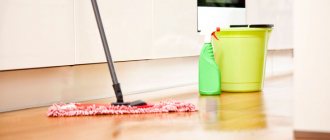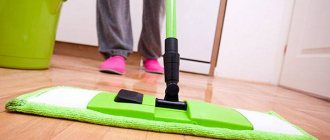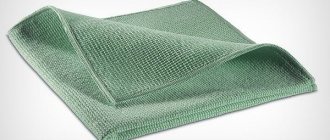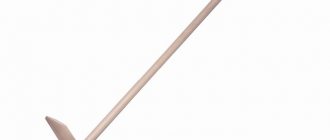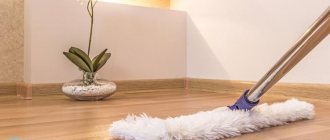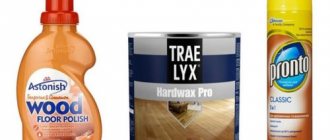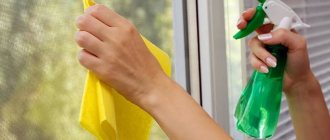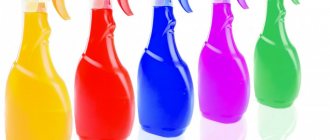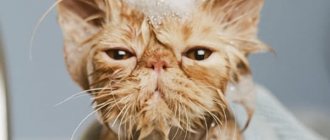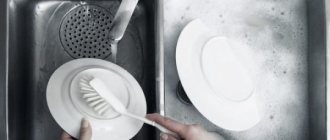Only regular washing of all surfaces in a living space helps to maintain cleanliness and get rid of pathogenic bacteria that can cause dangerous diseases. To ensure that cleaning does not take much time and is as effective as possible, it is necessary to use special compounds. You can buy them in specialized stores, or you can prepare a floor cleaner with your own hands from ingredients that are always available in any home. It will be as effective as the finished one.
Main causes of floor contamination
Dust and pet hair gradually turn into dirt that is hazardous to human health.
The surface of the flooring experiences maximum operational load. The floor is a platform for movement in the living space. Dust constantly accumulates on it. It mixes with particles of moisture present in the air and turns into dirt that sticks to your feet.
The situation gets worse if there are small children or pets living in the house. The first ones run around the apartment and litter, the second ones shed. Ventilating rooms opens the way for pathogenic bacteria to enter from outside. Viruses, microbes and even parasite eggs enter the living space along with the air. Regular cleaning of the floor covering helps get rid of them.
Harmful household chemicals
Are household chemicals harmful or not? The answer is clear - yes! This information really makes you think. Widely used air fresheners, for example, contain propane-butane and aldehydes, which have a neurotoxic effect on the human body; Many cleaning products contain anionic surfactants that are dangerous to the immune system. They provoke not only allergies - when they accumulate in the body, surfactants can cause serious disruptions in the functioning of the body, including damage to the liver, lungs and other internal organs. Antibacterial agents are particularly toxic – chlorine increases the risk of cancer.
But everything is not so categorical. And the old Russian proverb “To live clean is to be healthy” does not lose its relevance at all in the light of modern realities. Any of the harmful household chemicals can be replaced with a natural and harmless analogue. It is enough to visit a specialized online store of beauty and health products or create a purifier yourself. How to make detergent? More on this later.
How to properly wash floors
To ensure cleanliness, it is necessary to thoroughly clean all horizontal surfaces. It will be easier to do this if you adhere to the following algorithm:
- Clear the work area: remove unnecessary things from the floor surface, rearrange chairs, tables and floor lamps into another room, collect large debris.
- Vacuum and carefully collect dust.
- Prepare all the necessary equipment and select a floor cleaning product. Traditionally, preference is given to purchased household chemicals. There are compositions that quickly dissolve in water, are suitable for all types of coatings, do not require rinsing and effectively fight all types of pathogens. If you don’t have a ready-made concentrate on hand, you can easily prepare a floor cleaner at home.
- Start washing the floors from the most inaccessible places in the room, from the farthest corner from the front door. Gradually move towards the center, and then towards the doorway. In the end, right at the doorstep, you will have to collect the remaining garbage.
If after washing the floors there is a lot of moisture left on the flooring, it must be collected with a dry cloth. Microfiber copes best with this task.
If there are pets in the house
Dogs or cats living at home can affect the cleanliness of the apartment. To remove hair accumulations, you must adhere to the following rules:
- When cleaning, pay attention to corners and hard-to-reach areas where the most dirt accumulates;
- It is best to remove hair using a special roller attachment for a vacuum cleaner;
- If you have a lot of pets and don’t have time for daily cleaning, you can buy the cheapest washing robot vacuum cleaner.
If your pet periodically marks the apartment, you should not wash the puddle with plain water - this will only increase the unpleasant odor and increase the contaminated area. The following products will help you clean your floors:
- Potassium permanganate. Dissolve 5 crystals in 200 ml of water - the liquid should turn out to be light pink. The sponge is moistened with the product, the stain is wiped, the floor is washed with clean water and wiped dry.
- "White". The composition is diluted in water in a ratio of 1:10, the contaminated area is treated, washed with clean water and wiped with a dry cloth.
- Washing powder. If there is a strong smell of urine in the room, dissolve 1-2 tablespoons in 5 liters of water. powder, wash the entire floor with the product. To consolidate the result, you can wipe the coating with medical alcohol diluted with water.
Scratches often appear on the floor from the claws of pets. You can deal with them using the following means:
- Wipe damage on the wooden floor with a walnut core;
- to remove scratches, prepare a mixture of vegetable oil and vinegar, rub it into the surface and leave to dry for 2 hours;
- To remove damage from the surface of natural oak or mahogany, you need to dissolve 5 drops of iodine in 200 ml of warm water and wipe the floor with the liquid.
It is recommended to test its effect on an inconspicuous area before using any product.
Safe products and tools
Modern mops significantly save energy during cleaning.
There are a large number of useful devices that can help speed up the cleaning process and make it much easier. One of them is a mop. Ideally, it should have a handle that extends to your armpits. This will help you hold it comfortably in your hands and not strain your back when washing the floors.
To make it easier to collect garbage in the center of the room, you need to move the mop along the contour of the figure eight during the cleaning process. The mop cloth should not be too wet. A small amount of water is enough to collect dust and wash the dirtiest areas.
Manufacturers still offer traditional models of mops; there are modern models on sale - mops, in which the working part is securely attached to a telescopic handle. Special devices help to wet and wring out a rag without getting your hands dirty, and to clean floors efficiently without straining your back. Experts recommend buying them for anyone who has to frequently clean the house.
Washing linoleum
Linoleum is a floor covering that does not require delicate care. The best means for washing it are:
- Mellerud;
- Wa-Lin;
- HG;
- Sano Poliwix;
- PassionGold 1.5 l and others.
Mellerud perfectly cleans the protective coating of laminate flooring and protects it from dirt. Suitable for permanent use. To clean, you need to dissolve 1 cap of the product in a bucket of water.
Wa-Lin will perfectly clean the floor of iodine, brilliant green and stripes left by furniture and rubber soles. To properly wash linoleum, you need to dilute 20 ml of the product in 2 liters of water. On heavily soiled areas, apply the liquid for 4-5 minutes and then wipe off.
HG is intended for permanent use. For 3 liters of water you will need 250 ml of HG. The product does not need to be washed off the floor, as it is perfectly absorbed, does not allow slipping and does not make the coating sticky.
San Klin can be used not only for washing linoleum, but also for wiping tiles and wooden flooring. The product contains only natural substances, so it is harmless to the skin.
Folk remedies
Clean floors faster using special products. Manufacturers of household chemicals offer a large number of different compositions. Their use helps to clean floors efficiently and protect the surface of the floor covering from possible damage.
However, some housewives cannot use ready-made formulations due to health problems. Allergy sufferers and asthmatics should be careful when selecting components for cleaning floors. Any contact with aggressive concentrates can provoke an exacerbation of the underlying disease. Experts recommend using folk remedies that are prepared from ingredients that any housewife always has in her kitchen. Each coating has its own.
Linoleum
This is the most budget-friendly option for flooring and is very easy to maintain. If necessary, you can wash it with ordinary laundry soap: rub the microfiber with it, walk through the dirtiest places, and then rinse the surface with ordinary water. After washing, linoleum must be thoroughly wiped with a dry cloth; this will significantly extend the life of the floor covering.
To add shine, experts recommend treating the top layer of linoleum with a mixture of linseed oil and table vinegar (equal proportions). It is applied after the coating has been washed and thoroughly dried. A solution of milk and water is suitable for polishing and restoring shine. This composition must be rubbed into the linoleum once a month, using a soft suede or microfiber cloth.
Tree
A soap solution will help remove any remaining vinegar or other product from the surface.
If the floors in the house are covered with laminate or parquet, washing with a large amount of moisture is strictly contraindicated. Otherwise, the coating will swell and deteriorate. All you can count on is wiping with a damp, well-wrung out cloth. It collects dust easily.
When the floors are covered with solid boards, water with salt and soda will help remove grease from their surface. But this composition is not suitable if varnished laminate or parquet is used as the floor covering. Even laundry soap cannot be used in such a situation: such components will cause the varnish to lose its shine and crack.
A weak solution of vinegar (a spoon per liter of warm water) will allow you to thoroughly clean the floor. The floors are washed with it, then rubbed dry with a soft cloth. To clean parquet, use turpentine or gasoline. They pre-treat all greasy stains and stubborn stains. The products themselves are then removed from the surface of the dies with a soap solution. This type of cleaning can only be done in a well-ventilated area.
Stone
Washing floors covered with marble or porcelain stoneware does not cause any big problems. Dust and dirt can be easily removed with a regular soap solution. The stone is not afraid of moisture, so you can use a large amount of water and wash the surface with a mop. But still, you shouldn’t abuse it. Stone is a porous material; it absorbs moisture well and then takes a long time to dry.
It is not recommended to use abrasive products for cleaning stone floors. Rubbing them in can cause small scratches. They quickly become clogged with dust and the floor becomes dirty. If the stains do not respond to the soap solution, you can drip lemon juice on them and wait.
Universal recipe
There is a product that is suitable for removing stubborn stains from any floor surface:
- water (one glass);
- vinegar (1/4 cup);
- medical alcohol (3/4 cup);
- liquid dishwashing detergent (teaspoon);
- essential oil (15 drops).
The listed ingredients are mixed in one bowl, the resulting composition is poured into a spray bottle, sprayed onto the dirt and left for 10 minutes. Afterwards it is washed off with water. This product can be used to wash laminate flooring, tiles or stone tiles, mirrors, and stainless steel surfaces.
Carpet
Soft floors also need care. With their help, an atmosphere of home comfort and warmth is created in bedrooms, offices, and children's rooms. To clean such a coating, household chemicals are often used, but when its use is contraindicated for medical reasons, folk remedies come to the rescue. One of them is prepared from a liter of warm water, a piece of laundry soap and three tablespoons of vinegar. The soap bar does not dissolve completely, it is simply immersed in a vinegar solution, the water is stirred with it and lightly lathered. The finished composition is applied to the carpet with a brush. The dirty area is cleaned, after which the carpet is vacuumed and dried with a hairdryer.
Folk compositions provide cheap and healthy cleaning. By choosing the suggested recipes, you can take care of your flooring and keep your home clean at no cost.
Complex stains and hard-to-remove dirt: how to remove from different types of coatings?
Imagine that you have decided to renovate your house. Or you had to move into an apartment whose condition leaves much to be desired. You will be faced with the fact that the floors are covered with old dirt, which needs to be washed urgently. Contamination can be different - from drips with grease stains to traces of paint and varnish materials.
In case of repair, before starting, cover the entire floor with film or paper. This way you will protect the coating, if not from all stains, then from most of them, and thereby significantly reduce the time for subsequent cleaning. It is better to remove the carpet from the floor altogether.
Note! Construction dust and other contaminants associated with repairs require some caution. Therefore, before cleaning, put on clothes that you won’t mind throwing away, and protect your respiratory tract from harmful particles.
- Before you start deep cleaning, sweep the floors with a broom. A vacuum cleaner is not suitable for this; it blows out air, and with it dust. After this, spray the floor with a spray bottle, sweep away the dirt and remove lumps of mortar with a spatula. Wash the surface by adding a little detergent to the water, rinsing the cloth as often as possible.
- To get rid of paint marks, grease them with vegetable oil and leave for 20-30 minutes. Once the stain has softened, try gently scraping it off with a spatula. If the paint comes off easily, wipe the cleaned area with a soft cloth. Do not try to scrub off the dried paint too much; it is better to repeat the oil treatment again.
- Remove nitro paint and water dispersion with white spirit. It is better not to use acetone, it is more caustic and can damage the surface.
- If the stain is small, it can be cleaned off with nail polish remover.
- To remove oil paint stains, use vegetable oil. The remaining marks that have not been erased can be simply wiped off with a small amount of gasoline.
- You can easily wipe off water-based emulsion stains, especially fresh ones, with laundry soap. If the stain is already dry, moisten it with water, rub with laundry soap and let stand for 30 minutes. After this, it will be enough to wipe off the paint with a damp cloth.
- To remove limescale, first use a spatula to remove lumps and large stains. Dissolve ½ cup of sunflower oil in a bucket of hot water (50–60° C), soak a small piece of cloth in the solution and thoroughly scrub each stain. When finished, wash the entire floor with clean water, squeezing the cloth well. After this, wipe the surface dry.
- Just like with lime, you will clean the floor from whitewash, the only difference being that you will have to wash it several times. Whitewash dries quickly, leaving streaks, and it is not easy to deal with it right away. To speed up the process, wash the floor with a solution of 100 g of table salt in 10 liters of water.
- Potassium permanganate removes construction dust well, and in addition disinfects surfaces. Dilute potassium permanganate in warm water until it turns bright pink, wet a cloth, wring it out and wash the floor.
Universal method
Salt is suitable for all types of coating. It is customary in villages to wash floors with salt. To clean, you need to dissolve 100 g of the product in a bucket of warm water. After this, you should start cleaning.
The salt solution makes wood floors shine and protects tile surfaces from dirt.
What means to wash the floors is up to each housewife to decide for herself. Fortunately, today there is a huge selection of products for caring for different floor surfaces, so wet cleaning is not a problem for the modern woman.
